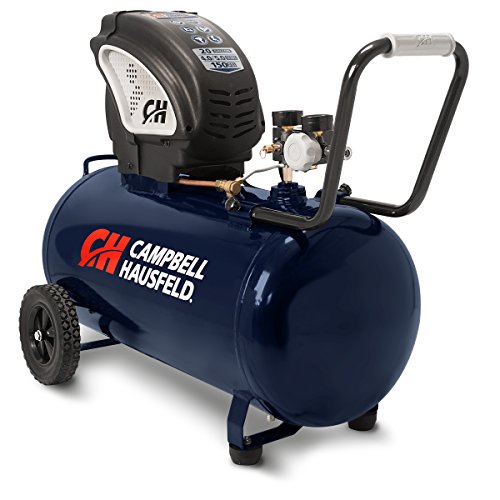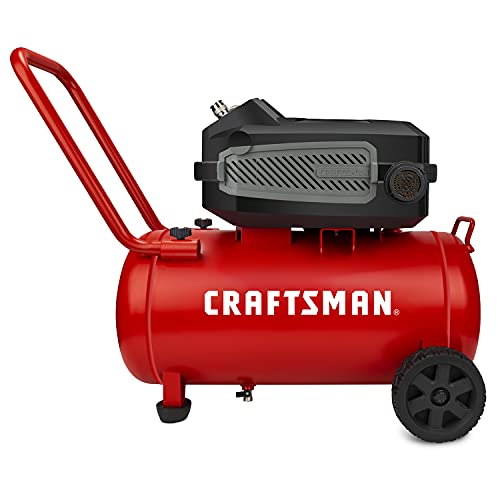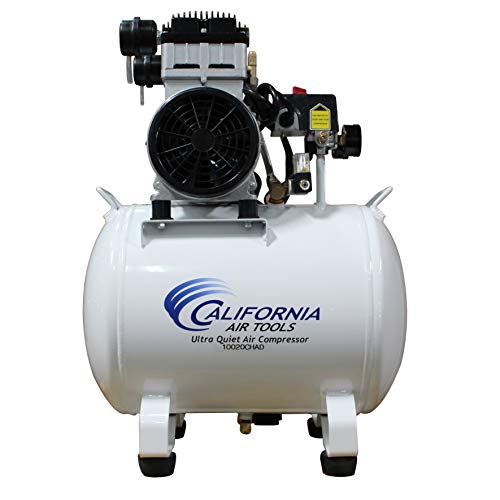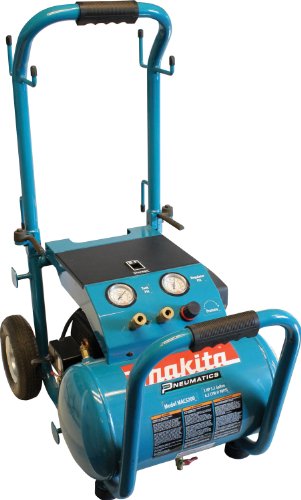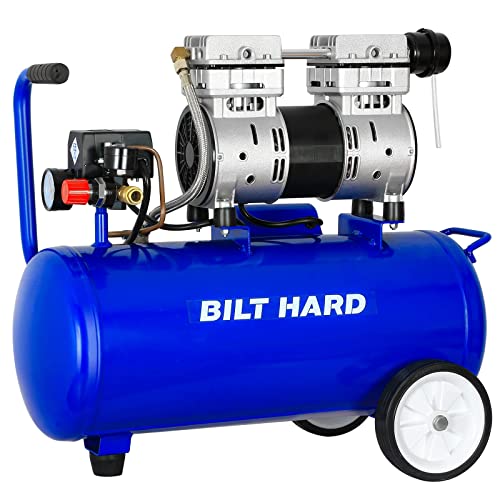The Best Horizontal Air Compressors To Upgrade Your Workspace
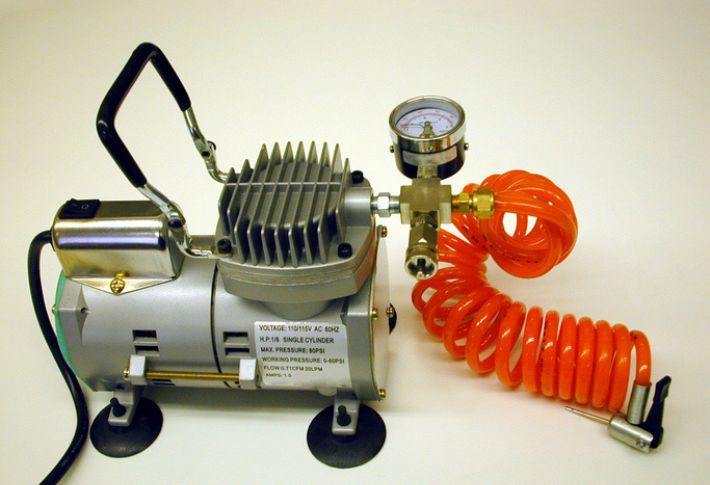
- Best Overall: Campbell Hausfeld Horizontal Air Compressor Shop Now ➔
- Most Reliable: Craftsman Horizontal Air Compressor Shop Now ➔
- Most Efficient: California Air Tools Horizontal Air Compressor Shop Now ➔
- Most Powerful: Makita Horizontal Air Compressor Shop Now ➔
- Most Quiet: Gülife Horizontal Air Compressor Shop Now ➔
- Buying Guide: Horizontal Air Compressors
- People Also Asked
- How is a horizontal air compressor different from a vertical air compressor?
- What is the best type of motor for a horizontal air compressor?
- Can I use a horizontal air compressor to power air tools?
- How often should I change the oil in my horizontal air compressor?
- How do I properly maintain my horizontal air compressor?
- Related Reviews
Comparing the Top Horizontal Air Compressors of 2024
Best Overall
The Campbell Hausfeld Horizontal Air Compressor is a must-have tool for anyone who wants to get the job done right. Its impressive maximum pressure of 150 PSI ensures you’ll have the proper airflow to power through any application, big or small. It has a generous 20-gallon capacity and an oil-free pump; this compressor can run for extended periods while maintaining maximum efficiency.
The control panel is thoughtfully designed and easy to read, giving you complete control over the air manipulation. This compressor can handle everything from filling tires to powering air tools. You can easily take it anywhere with its durable steel handle and large wheels. The quick access filter makes maintenance a breeze, ensuring your unit stays in shape for years. This product is the best because of its impressive pressure, durability, and quick access filter.
Pros
- Quick fill-up time
- Fills large tanks relatively fast
- Sturdy and well-built design
Cons
- It’s deafening
Most Reliable
The Craftsman Horizontal Air Compressor is the ultimate choice for anyone seeking a robust and reliable air compressor that can handle even the most challenging jobs. This machine provides plenty of air for longer run times with tools boasting an impressive 10-gallon ultra-large tank and a max tank pressure of 175 psi. Its powerful motor and pressure allow for quick compressor recovery time, ensuring you’ll never have to wait long to return to work.
This sturdy and durable compressor makes it an investment that will last years. The two large rubber wheels make moving this compressor a breeze, while the noise level of 80 dBA provides a comfortable and quiet work environment. And with its oil-free design, there’s no need for time-consuming maintenance, saving you both time and money. And with all the essential accessories included in the purchase, such as a six-foot cord, a ball drain valve, a quick coupler, a plastic filter, and two rubber wheels, you’ll have everything you need to get started immediately.
Pros
- Lightweight and quiet
- It comes with easy-to-use controls
- Dependable with years of reliable use
Cons
- Short power cord
Most Efficient
The California Air Tools Horizontal Air Compressor is a game-changer for anyone needing a high-performing, low-noise compressor. With its mighty motor, this compressor can deliver maximum pressure, making it a force for even the most challenging tasks. Also, its remarkably quiet 70-decibel rating is a true standout feature, ensuring that operators and nearby personnel can work in a peaceful and comfortable environment.
It is effortless to maintain and use. Its oil-free pump eliminates the need for messy lubricants, reducing maintenance and operating costs associated with traditional oil-based pumps. And with a 10-gallon steel tank and an automatic drain valve, this compressor is perfect for handling long-duration tasks while conveniently draining condensation from the tank.
Pros
- Very quiet and works brilliantly
- Steel tank for durability
- Great for DIYers at home
Cons
- The auto drain feature is very loud
Most Powerful
The Makita Horizontal Air Compressor is a powerhouse that will blow away your expectations. Its powerful motor produces whopping pressure, ensuring you can finish the job quickly and efficiently. Its cast iron pump, Big Bore cylinder, and piston deliver faster recovery times and superior performance, leaving you in awe. Also, this air compressor is oil lubricated, which maintains low running temperatures and reduces wear, making it perfect for heavy-duty applications. And with its cast iron cylinder, it’s built to last, ensuring durability and longevity that you can count on.
Whether you’re working on a DIY home project or a complex industrial application, this machine will get the job done quickly and efficiently. The removable cylinder allows easy maintenance, making it a breeze to keep this machine in tip-top shape. It also features a folding handle with a low-profile design, making it incredibly easy to store when not in use.
Pros
- Powerful motor for pressure
- Wheels provide good portability
- Folding handle and hose wrap for easy storage
Cons
- The storage compartment is tiny
Most Quiet
The Gülife Horizontal Air Compressor has one HP motor and a maximum of 120 PSI, providing the perfect balance of stored air power and dependable performance. At the same time, the oil-free and maintenance-free pump system ensures improved tool performance with more extended tool run times. But what sets this compressor apart is its ultra-quiet operation. Running at only 1680 RPM, it’s up to 80% quieter than similar workshop/auto compressors, making it the ideal choice for those concerned with noise pollution. And its safety valve and easy-to-transport design provide top-notch performance and unbeatable convenience.
Also, it is incredibly versatile, making it perfect for a wide range of pneumatic and woodworking tools, from inflation and finishing nailers to various industrial fields. And its 8-gallon tank provides the necessary power without having to overwork itself, ensuring that you get the work done quickly and efficiently.
Pros
- Features quiet operation
- Charges tank quickly
- Portable and easy to handle
Cons
- Requires frequent draining to prevent rust
Buying Guide: Horizontal Air Compressors
A horizontal air compressor is essential when it comes to powering your workspace. With a horizontal air compressor, you can always rely on a steady flow of compressed air to keep your tools running at maximum efficiency. The assurance of having a reliable air compressor is worth its weight in gold.
But with so many models available, selecting the perfect horizontal air compressor can be daunting. But don’t worry! Our comprehensive buyer’s guide will help you pick the right option and choose the ideal horizontal air compressor that suits your budget and requirements.
How To Pick the Right Horizontal Air Compressor
Maximum pressure
Maximum pressure is one of the most important factors when looking for an air compressor. The higher the maximum pressure, the PSI rating of pounds per square inch, the more influential the compressor. Compressors with higher pressure ratings can work with more demanding applications such as sandblasting and spray painting.
Flow rate
The flow rate, CFM rating, which is cubic feet per minute, measures how much air the compressor can move in a given time, affecting its overall performance. A higher CFM rating means you can more air can simultaneously, enabling faster work times and better results.
Horsepower
The horsepower of the motor determines how much power the compressor can generate. Generally speaking, electric motors start at one horsepower and can range up to 5 or even ten horsepower for larger compressors. Gasoline-powered compressors are available, too.
Portability
Some compressors are very portable, allowing for easy transportation between job sites. Smaller, lightweight models are typically easier to move than their heavier counterparts, but they may also lack some of the power of larger stationary models. Consider getting a smaller compressor that’s easier to move if you need something to transport between different job sites quickly.
Type of motor
Air compressors have two main motors: direct-drive and belt driven. Direct-drive engines are more straightforward and cost-effective, but belt-driven motors offer more power and allow variable speed controls. Suppose you wish to use your compressor for heavy-duty projects or require variable speed control capabilities. A belt-driven model may be worth considering.
Noise level
Some compressors are louder than others due to the type of motor used and other internal components. If noise is an issue for you or you will be using the machine in an enclosed space, it pays to check out how loud it is before buying one so that you don’t get surprised by any loud noises later on down the line.
Capacity
Larger capacity compressors will hold more air, so they will take less time to re-fill between uses. It can be vital if you plan on using your compressor often and want to start immediately while it repeatedly recharges during long use sessions.
Price
Price is an essential factor when making any big purchase! Be sure to shop around before deciding so that you get the best deal possible. It’s important to remember that buying from a reputable brand can give you added security when it comes to warranty coverage or replacement parts in case something should happen down the line.
Safety Considerations When Using Horizontal Air Compressors
Ensuring safety while operating a horizontal air compressor is of paramount importance. This powerful equipment can cause injuries or damage if not handled with care. Here are some safety measures to take when using this equipment.
Pressure relief valves
A pressure relief valve is an essential safety feature in air compressors. It prevents excessive pressure build-up within the tank, possibly leading to dangerous explosions. The valve automatically releases air when the internal pressure surpasses a predetermined level, ensuring the system remains within safe operating limits. Always inspect and maintain the pressure relief valve to guarantee it functions correctly and keeps you and your equipment safe.
Overload protection
Overload protection is another crucial safety feature that safeguards the air compressor motor from overheating and potential damage. If the motor draws excessive current or operates at high temperatures, the overload protection mechanism automatically shuts off the engine, preventing burnout or other malfunctions. This feature not only ensures the longevity of your air compressor but also reduces the risk of electrical hazards and accidents.
Proper ventilation
Operating an air compressor in a well-ventilated area is vital to avoid the buildup of potentially harmful fumes, especially when using gas-powered models. Carbon monoxide emitted by gas engines can be dangerous if inhaled in large quantities. For electric models, proper ventilation helps keep the motor cool, reducing the risk of overheating. Use the air compressor in an open space with sufficient airflow, or install a ventilation system if working indoors.
People Also Asked
How is a horizontal air compressor different from a vertical air compressor?
A horizontal air compressor has a horizontal cylinder, while a vertical air compressor is vertical. A horizontal air compressor is typically more portable, while a vertical air compressor is better suited for applications that require a higher capacity.
What is the best type of motor for a horizontal air compressor?
The best type of motor for a horizontal air compressor depends on the specific application and usage. A single-phase motor is ideal for smaller compressors in workshops or at home. A three-phase motor may be more suitable for larger compressors used in commercial or industrial settings.
Can I use a horizontal air compressor to power air tools?
Yes, you can use a horizontal air compressor to power various air tools, such as nail guns, air ratchets, and impact wrenches. But ensuring the compressor has enough power and capacity to run the specific tool is essential.
How often should I change the oil in my horizontal air compressor?
Change the oil in a horizontal air compressor every 500 to 1,000 hours, depending on the manufacturer's guidelines. It's essential to check the oil level regularly and change it if it appears dirty or contaminated.
How do I properly maintain my horizontal air compressor?
Proper maintenance of a horizontal air compressor includes regular checks of the oil level and quality, replacing or cleaning the air filter, inspecting the belt and pulleys, and draining the water from the tank regularly. Following the manufacturer's guidelines and scheduling regular maintenance with a qualified technician is also essential.
Article Contributors
The Woodsmith Review Team’s product reviews and in-depth guides are here to help you choose the best tools and gear to build great-looking projects confidently. Woodsmith is reader-supported: When you buy through links on our site, we may earn an affiliate commission. Large language models (like Artificial Intelligence) may have been used in the research and creation of the content.
Inquiries regarding specific articles or product testing should be sent to aimperiapt@gmail.com

